Related Research Articles
Amelia Peabody Emerson is the protagonist of the Amelia Peabody series, a series of historical mystery novels written by author Elizabeth Peters. Peabody is married to Egyptologist Radcliffe Emerson and has one biological child, Walter "Ramses" Peabody Emerson.
Barbara Louise Mertz was an American author who wrote under her own name as well as under the pseudonyms Elizabeth Peters and Barbara Michaels. In 1952, she received a PhD in Egyptology from the University of Chicago. She was best known for her mystery and suspense novels, including the Amelia Peabody book series.
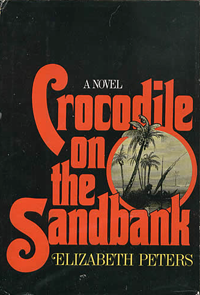
Crocodile on the Sandbank is a historical mystery novel by Elizabeth Peters, first published in 1975. It is the first in the Amelia Peabody series of novels and takes place in 1884–1885.

The Curse of the Pharaohs is a historical mystery novel by Elizabeth Peters, first published in 1981 and the second in the Amelia Peabody series of novels; it takes place in the excavation season of 1892–1893.

The Mummy Case is the third of a series of historical mystery novels written by Elizabeth Peters and featuring the character Amelia Peabody. It was first published in 1985. The story is set in the 1894–1895 dig season in Egypt.

Lion in the Valley is the fourth novel in a series of historical mystery novels, written by Elizabeth Peters and featuring fictional sleuth and archaeologist Amelia Peabody. It was first published in 1986. The story is set in the 1895–96 dig season in Egypt.

Deeds of the Disturber is the fifth in a series of historical mystery novels, written by Elizabeth Peters and first published in 1988. It features fictional sleuth and archaeologist Amelia Peabody. This is the only book in the series which takes place entirely in England, mainly in London in Summer 1896.

The Last Camel Died at Noon is the sixth in a series of historical mystery novels, written by Elizabeth Peters and featuring fictional sleuth and archaeologist Amelia Peabody. It was first published in 1991. This story in the historical mystery series has a new genre; Last Camel satirizes adventure novels in the tradition of Henry Rider Haggard. One reviewer considered this an homage to Haggard. The story is set in the 1897–98 dig season, partly in Egypt, then moving west to Sudan.

The Ape Who Guards the Balance is the tenth in a series of historical mystery novels, written by Elizabeth Peters, first published in 1998, and featuring fictional sleuth and archaeologist Amelia Peabody. The story is set in the 1906–1907 dig season in Egypt.
Sethos is the nom de guerre of the shadowy "Master Criminal" in the Amelia Peabody series of historical mystery novels.
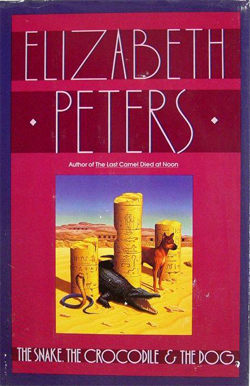
The Snake, the Crocodile, and the Dog is the seventh in a series of historical mystery novels, written by Elizabeth Peters and featuring fictional archaeologist and sleuth Amelia Peabody. It was first published in 1992. The story is set in the summer of 1898 in England and the 1898-1899 archaeological dig season in Egypt.

The Hippopotamus Pool is the eighth in a series of historical mystery novels, written by Elizabeth Peters and first published in 1996. It features fictional sleuth and archaeologist Amelia Peabody. The story is set in the 1899-1900 archaeological dig season. Although one review found the novel "heavy handed" in its style, while recognizing the many fans of this series, other reviewers enjoyed the wit, the "melodramatic 19th-century writing style" and the dandy "romantic nonsense".
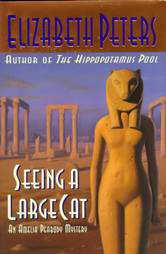
Seeing a Large Cat is the ninth novel in the Amelia Peabody historical mystery series by Elizabeth Peters, first published in 1997. The story takes place in Egypt during the archaeological dig season of 1903-1904.

The Falcon at the Portal (1999) is the 11th in a series of historical mystery novels by Elizabeth Peters, first published in 1999. It features fictional archaeologist and sleuth Amelia Peabody. The story is set in the 1911–1912 dig season in Egypt.
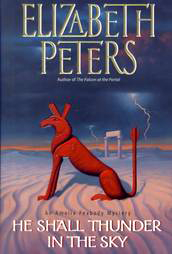
He Shall Thunder in the Sky is the 12th in a series of historical mystery novels by Elizabeth Peters, first published in 2000, and featuring fictional archaeologist and sleuth Amelia Peabody. The story is set in the 1914–15 dig season in Egypt.

Lord of the Silent is the 13th in a series of historical mystery novels, written by Elizabeth Peters and featuring fictional sleuth and archaeologist Amelia Peabody. It was first published in 2001. The story is set in the 1915–1916 dig season in Egypt.
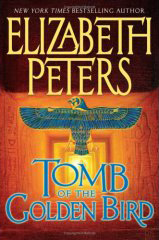
Tomb of the Golden Bird is the 18th in a series of historical mystery novels, written by Elizabeth Peters and first published in 2006. It features fictional sleuth and archaeologist Amelia Peabody. The story is set in the 1922–1923 archeological dig season in Egypt, and is currently the final novel in the internal chronological scheme of the series.

The Amelia Peabody series is a series of twenty historical mystery novels and one non-fiction companion volume written by Egyptologist Barbara Mertz (1927–2013) under the pen name Elizabeth Peters. The series is centered on the adventures of the unconventional female Egyptologist Amelia Peabody Emerson, for whom the series is named, and an ever-increasing number of family, friends, allies, and characters both fictional and based on historical figures. The novels blend mystery and romance with a wryly comic tone, and at times also parody Victorian-era adventure novels such as those written by H. Rider Haggard. The series was published between 1975 and 2010, with the final, posthumous novel appearing in 2017.
Evelyn Emerson is a fictional character from the Amelia Peabody series of historical mystery novels by Elizabeth Peters. She is the closest friend, and later sister-in-law, of the protagonist, fictional sleuth and archaeologist Amelia Peabody.
References
- ↑ In Seeing a Large Cat (hardback ed., p. 384) Ramses mentions that his father was "almost thirty" at the time of his marriage in 1884, which would put his date of birth at some point in 1854 or 1855. In the Compendium , there is a reference to Amelia, but not Emerson, on what might have been a final voyage to Egypt in 1939, however it is unknown whether Emerson had died by this time or was simply not with her at the time the event described took place.
- ↑ Amelia Peabody's Egypt: A Compendium , pg. 208.
- ↑ These were rattled off by Emerson to an admiring group of dignitaries in The Last Camel Died at Noon , chapter 8.